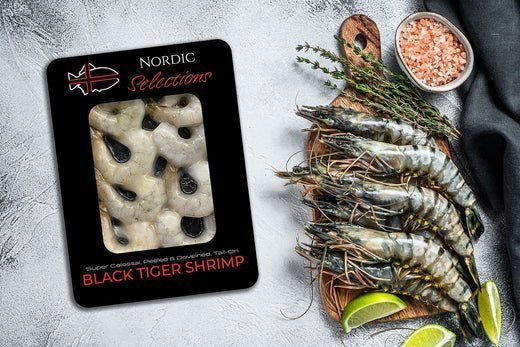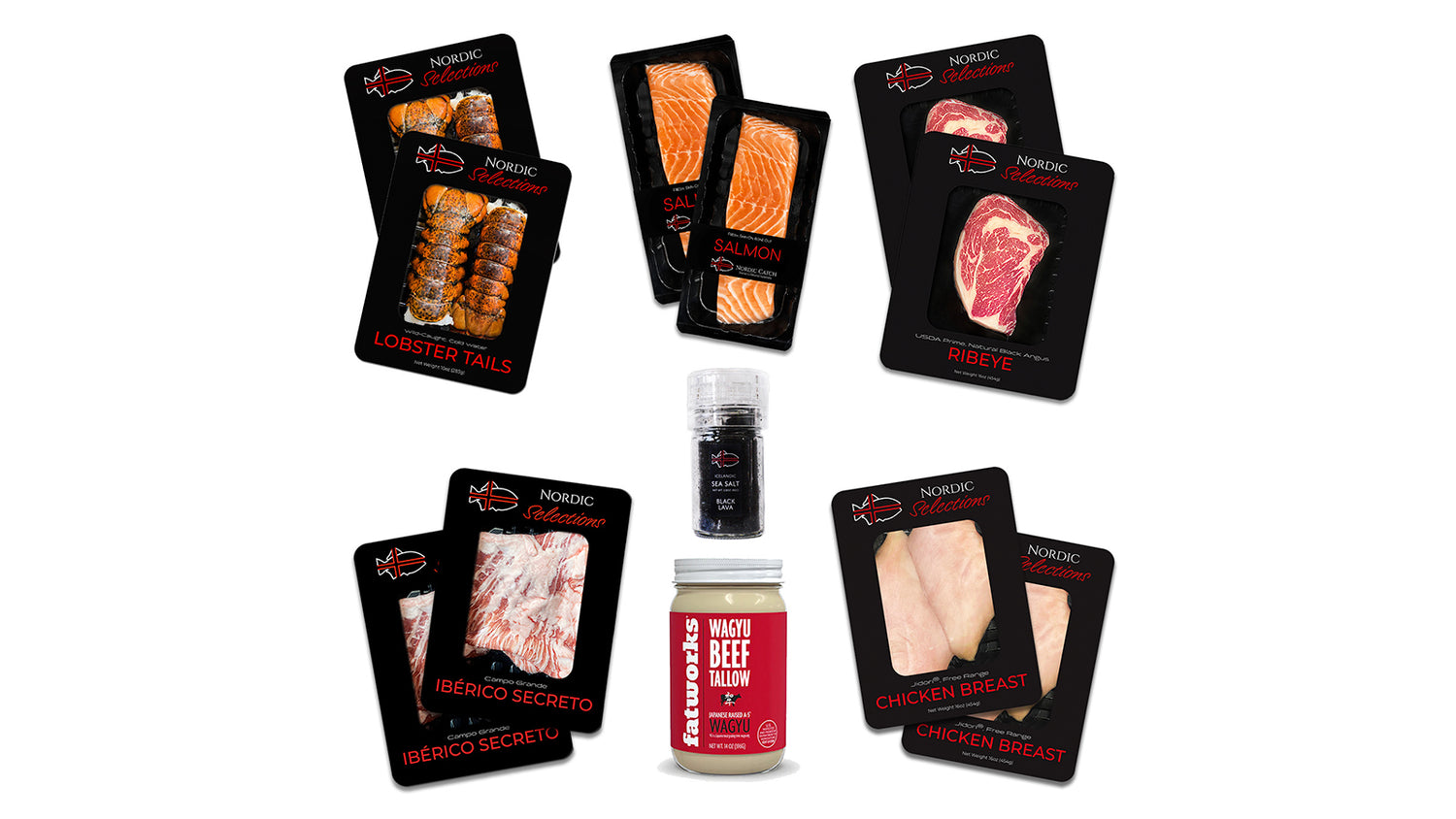
How to Store Seafood in the Fridge and Freezer
Navigating seafood safety and storage can take time and effort. There's so much to consider from the market to your plate, and you want to protect the investment you've made, especially if you've just had fresh seafood delivered to your door.
We're here to help you understand the ins and outs of storing seafood in your fridge. It's not just about preserving your food's taste — it's also about ensuring your seafood is safe to eat. So, let's explore how to keep your seafood fresh and flavorsome.
Why Is Proper Seafood Storage So Important?
Proper seafood preservation isn't merely a matter of taste — it plays a critical role in maintaining your health and safety. Storing seafood under appropriate conditions helps prevent the spread of bacteria and other pathogens, reducing the risk of foodborne illnesses. Additionally, proper storage techniques enhance the longevity and freshness of wild-caught or farm-raised seafood, ensuring it retains its ideal flavor and texture when it's time to enjoy.
Seafood Storage Guidelines and Shelf Life Basics
When considering the shelf life of farm-raised seafood, it's crucial to remember that various factors contribute to how long the seafood remains safe for consumption. These include the freshness of the seafood at purchase time, the temperature at which it's stored, and the presence of any preservatives. For instance, you should ideally consume stored fish and shellfish within 1 to 2 days. At the same time, seafood salads, composed of perishable dressings like mayonnaise, are best eaten within a day or so.
Different Types of Seafood = Different Storage Needs
Different types of seafood, such as fish, shrimp, and shellfish, have varied storage requirements. Fish fillets, for instance, are best stored in a single layer in a zip-top bag on a tray lined with ice, nestled on the bottom shelf at the back of the fridge. Shellfish must be kept alive until cooking and not stored in airtight conditions. Shrimp should be kept in the coldest part of the fridge, wrapped in ice, and used within 1 to 2 days.
What's the Ideal Temperature for Storage?
The optimal temperature range for refrigerated seafood storage is between 0°C and 4°C (32°F to 40°F). Any temperature deviations might negatively impact the seafood's freshness. Above 4°C, you encounter the "Temperature Danger Zone," a range between 40°F and 140°F where bacteria proliferate rapidly. Keep cold seafood below 40°F to avoid foodborne illness.
Best Practices for Refrigerating & Freezing Seafood
Refrigerating seafood involves more than simply tossing it in the fridge. To maximize your seafood's shelf life and quality, follow these tips:
- Keep your refrigerator at or below 40°F (4°C).
- Wrap your leftovers appropriately and store them in the fridge within 2 hours.
- Use airtight seafood storage containers to prevent bacterial contamination.
- Rancid, sour, fishy, or ammonia odors in raw or cooked seafood indicate spoilage — discard any smelly items.
- Oysters, scallops, and mussels are highly perishable, so consume them within 24 to 48 hours of purchase.
- Always check oysters for freshness by tapping on their shells — they will close if they're still alive.
How to Store Fresh Seafood
Store fresh fish and shellfish in the coldest part of your refrigerator, ideally at temperatures below 40°F (4°C). It’s best to use fresh seafood within 1-2 days of purchase for maximum freshness. If you need to store it longer, consider placing the seafood on a bed of ice in a shallow dish to maintain its temperature. Ensure that any ice used is drained regularly to prevent the seafood from sitting in water. For shellfish like clams, mussels, and oysters, keep them in a breathable container, such as a mesh bag or bowl covered with a damp cloth, and avoid sealing them in airtight containers. Always check for signs of spoilage, such as off smells or unusual textures, before cooking or consuming.
How to Store Frozen Seafood
You can store bulk seafood indefinitely from a safety perspective. Still, quality is best when you consume it within specific timeframes. For raw fish, 3-8 months is ideal, while you can store shellfish for 3-12 months. Consume cooked fish, however, within three (3) months. If flash-frozen at sea, you can store spot prawns in the freezer for up to a year without compromising quality. By freezing seafood rapidly at sea like this, products like fish and spot prawns can maintain their quality in the freezer for up to 2 years.
Shopping in the supermarket? Check the label to confirm whether or not you're purchasing carbon monoxide treated fish, a somewhat manipulative storage tactic that may put you at risk.
How Long Will It Last?
Here are some specific storage times for different types of seafood, from fresh, sushi-grade seafood to shellfish and other types.
Fresh Fish
- Lean fish (e.g., cod, haddock): Best consumed within 1-2 days when refrigerated. When adequately frozen, they can be stored for up to 6 months.
- Fatty fish (e.g., salmon, mackerel): Due to their higher oil content, these can last up to 3 days in the fridge. Their shelf life extends to 3 months when vacuum-sealed and frozen.
Shellfish
- Shrimp: When refrigerated, they should be used within 1-2 days. They can be frozen for up to 3 months.
- Crab: Remains fresh in the fridge for 1-2 days and up to 10 months when frozen.
- Lobster: Typically maintains its freshness for a day in the refrigerator and up to 12 months when frozen.
- Clams, mussels, and oysters Can last 2-3 days in the fridge. Freezing is not recommended, as it can negatively affect their texture.
- Spot prawns: Can last up to 3 days in the refrigerator before cooking. If flash-frozen at sea, they can be stored in the freezer for up to a year.
Other Seafood
- Squid & octopus: Can be stored in the refrigerator for up to 2 days and frozen for up to 3 months.
- Scallops: Suitable for a refrigerator's shelf life of 1-2 days and can be frozen for three (3) months.
Signs of Spoilage
One of the critical aspects of seafood safety is identifying spoilage. This knowledge can protect you from experiencing seafood-related foodborne illness. Vital signs of spoilage include:
- Visual indicators: Fresh seafood is vibrant, shiny, and wet, though there are several other ways to tell if seafood is fresh or not. Discoloration, faded coloring, or dark or dry areas are signs of spoilage.
- Smell & texture: A strong, overpowering fishy smell indicates spoilage. Fresh fish should have a mild scent, similar to the sea, and firm, tightly held-together flesh. Slimy, mushy, or fish that falls apart quickly is likely spoiled.
- Avoid the Danger Zone: Seafood should not sit out in the temperature Danger Zone of 40°F-140°F, where bacteria thrive. Keep cold seafood below 40°F and hot seafood above 140°F.
Canned Seafood Shelf Life
Commercially canned fish, such as tuna, can be stored in a pantry for up to five (5) years. However, to ensure safety, home-canned fish should only be stored for one year.
Frequently Asked Questions
How long can seafood be in the fridge?
Fresh seafood should generally be consumed within 1 to 2 days after purchase when stored in the refrigerator at temperatures below 40°F (4°C) for optimal quality. Shellfish like mussels and clams should be used within 2-3 days, while oysters can last up to 7-10 days if stored properly.
How long can you store fresh scallops in the fridge?
You can store fresh scallops in the refrigerator for up to two days, but ideally, you should cook them within a day. If you anticipate not cooking them within this time, consider freezing the scallops for better shelf life.
How long can you keep octopus in the fridge?
Octopus can be kept in the fridge for about 1 to 2 days after purchase. If cooked, it should be consumed within 3 days for optimal freshness.
Is it safe to consume cooked shrimp after five days of storage?
Cooked shrimp can be safely consumed within three to four days of storage in the fridge. When reheating, use low temperatures to avoid a rubbery texture. Alternatively, enjoy them cold or at room temperature.
What's the shelf life of thawed shrimp in the fridge?
According to the USDA, thawed shrimp can be stored in the fridge for one to two more days before they need to be cooked. However, it's advisable to keep them within a 48-hour storage period.
How long can I store thawed seafood in the fridge?
Thawed fish can stay in the refrigerator for up to two days, while cooked fish is good for three to four days. Check out our guide on thawing frozen seafood for maximum flavor and texture.
Can I re-freeze the thawed shrimp?
According to the U.S. Food and Drug Administration, you can safely re-freeze shrimp that you thawed correctly in the fridge or cold water. However, their maximum hold time at room temperature throughout this process should be at most two hours.

